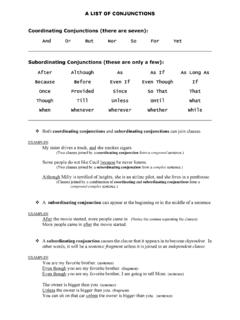Transcription of COMPLEX SENTENCES AN ANALYTICAL GRAMMAR FOR …
1 COMPLEX SENTENCESAN ANALYTICAL GRAMMAR FOR ADVANCED ESL STUDENTSflMarch 1995 TABLE OF CONTENTSTABLE OF ONE: SIMPLE SENTENCES ..1sentence definitions of the names of the sentence SENTENCES and sentence TWO: WORD class in multiple word the functions of parts or parts of sentence and of some word classes:..13 CHAPTER three : COMPOUND AND COMPLEX clauses as sentence classification of dependent FOUR: FINITE AND NON-FIINITE and non-finite of non-finite FIVE: ADJECTIVE or clause introducers?
2 35relative pronouns as subjects and of relative of adjective and non-restrictive adjective catalogue of relative and : a possessive relative adverbial relative pronouns:where and prepositional relative relative adjective adjective adjective that can be confused with adjective SIX: NOUN clauses, adjective clauses, and adverbial clauses as subjects, objects, and semantic and the grammatical views of subjects and clauses as appositives, objects of prepositions, and adjective complements.
3 53appositive noun objects of as adjective Clauses Classified according to Internal of Classification of Noun of Noun of adverbial adverbial adverbial time concessive condition clauses of EIGHT: OTHER TYPES OF functions of the in comparative functions of more within the sentence role of comparative supplementive position of supplementive subjects of supplementive with relative NINE: SPECIAL TYPES OF and noun existential KEYS TO THE ONE SIMPLE SENTENCESTHESE ARE THE TERMS THAT WILL BE INTRODUCED IN CHAPTER ONE:semanticalrefersimple sentencesentence partsubjectobjectdirect objectindirect objectcomplementsubjectobjectadverbialad junctdisjunctconjunctSIMPLE SENTENCES To understand English sentence structure it is necessary to understand what asimple sentence is.
4 Unfortunately, although simple SENTENCES are simple,understanding them is not always easy. This is not because there is anything reallydifficult about the SENTENCES themselves; it is because, in the beginning, thinkingabout language is difficult, sometimes even than thinking about how we are speaking and writing, we usually prefer justto speak or write. Similarly most people are content to drive cars or use computerswithout thinking much about how these things work. There is a difference though:Only a few people really understand cars or computers, but, in a way, we allunderstand language because, we are not only constantly using it, but creating ittoo by making SENTENCES that no one has ever used before.
5 So keep in mind, ifyou have any difficulty with the ideas in these notes, that you alreadyunconsciously understand English GRAMMAR and that, in studying it, you are onlymaking your knowledge / Simple SentencesSENTENCE PARTS Simple SENTENCES , like other sorts of sentence, begin with capital letters and endwith periods, and once again like other sorts of sentence simple sentenceshave parts. We will call these sentence are five sentence parts:subjectsverb phrasesobjectscomplementsadverbialsTHE FIRST LETTERS OF THESE NAMES MAKE AN EASILY-REMEMBERED WORD.
6 SVOCABRIEF DEFINITIONS OF THE NAMES OF THE SENTENCE PARTS We can explain subjects from a semantical point of view that is from thepoint of view of their meaning by saying that subjects are words, or groups ofwords, that typically tell us who or what is doing the a grammatical point of view, we can describe subjects by saying that theytypically come before verb phrases. In the majority of SENTENCES the subject comesat the beginning although the first sentence part in a sentence is often anadverbial.
7 We can also say that subjects have a nominal or noun-like quality: Theyare nouns or noun phrases or noun clauses . (These terms will be explained inChapter Two.) Verb phrases defined semantically are words, or groups of words, that typicallysay what action is being done or what is happening. Speaking grammatically, wecan define verb phrases as sentence parts that typically come after subjects andbefore objects. We can also say that verb phrases, unlike other sentence partsundergo a variety of changes from the present tense to the past tense, forexample, and from the active voice to the passive are a couple of very short SENTENCES that contain only a one-word subject and aone-word [SUBJECT] sings.
8 [VERB]Jack [SUBJECT] criticizes. [VERB] Objects, semantically speaking, are words, or groups of words, that say to whomor what the action is being done. Grammatically defined, they typically followverbs and they can, in most cases, be made into the subjects of passive / Simple SentencesSusie sings songs. [OBJECT]Jack plays the piano. [OBJECT]The passive versions of these SENTENCES areSongs are sung by piano is played by are two kinds of object, direct objects and indirect sings Jack [INDIRECT OBJECT] a song.
9 [DIRECT OBJECT]The indirect object refers to the person or thing to or for whom the action is speaking, indirect objects can be identified by the fact that they can betransformed into prepositional indirect objects .Susie sings a song to Jack. [prepositional indirect object]Only some verbs can take indirect objects. Some of the most common are: give, take,sell, tell, ask, send, feed. There are two types of complement object complements and subjectcomplements.
10 Semantically speaking, we can say that a subject complement names,or refers to, the same thing that the subject names or refers to; and we can say thatan object complement refers to the same thing that the object refers speaking, subject complements have two important characteristics:Like objects, they follow verbs, but they can only follow a special class of verbscalled intensive verbs, verbs that are used between two words or phrases bothof which refer to the same thing. (Be, seem, appear, stay, and become areexamples of intensive verbs.)
